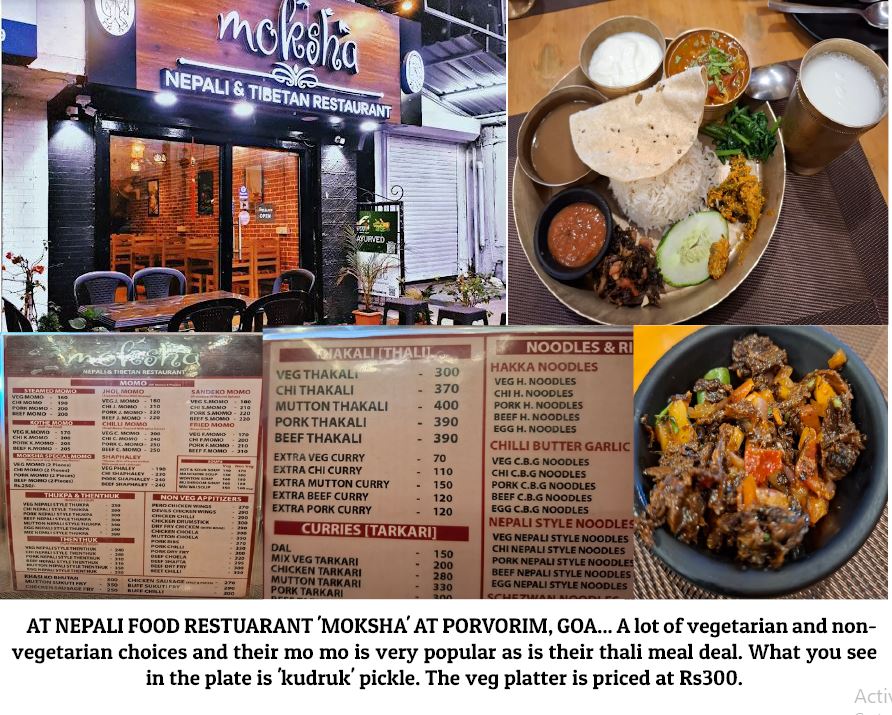Goa is abuzz with excitement as vintage bike and car owners, users, collectors and fans are decking […]

A NEPALI THALI MEAL AT `MOKSHA’
Eating is Fun / Eating is Yuck! - A variety food column, June 21- June 27, 2025, Life & Living June 20, 2025OCCASIONALLY a friend says “I’m taking you for a meal!” I quickly make my excuses all around and go. This time around I discovered that if there’s such a large population of Nepali folk working in Goa, there’s got to be a Nepali food eatery around regardless of whether the Nepali folk go there to eat or not! Non-Nepali Goans definitely go to this cosy eatery Moksha at Porvorim (just about opposite the Mall de Goa) which is a desirable quiet retreat most week days, for those who take a shine to the cleaner notes of the north-eastern or the oriental cuisines of southeast Asia – my friend Gauri loves the food here and so do I, wish there was a Moksha in Panjim too.
Take a look at the menu and I notice how many varieties of mo mo (of steamed dumpling fame) are listed, I always say mo mo or wantons or spring rolls must retain their original steamed avatar although nowadays they’re most grossly fried affairs everywhere. I mean, the steamed oriental spring roll has varnished, although I look for them in menus every time, they can’t be found for money or love except perhaps in discerning Chinese homes.
Mercifully one may get steamed mo mo here and there though and if they’re in a Nepali place, they’re freshly made and far superior to the assembly line versions sold by corporatized industrial cloud kitchens or whatever kind of kitchens (where mo mo are manufactured in bulk and maybe deep frozen and several days or weeks old by the time they arrive at branded and very well marketed glamorous air-conditioned outlets).
A far cry from what you will get at a family-run place like Moksha which is both “Nepali & Tibetan Restaurant” and its general menu offers more meaty stuff and some vegetarian fare which is good for me – along with various mo mo, lots of noodles Hakka or in chilli butter garlic, also Nepali-style waiwai noodles which are the softer misty white ribbon noodles or maybe barley flour noodles, for the Nepali people like to use barley flour…there are the “tarkari” curries stew-style, all the fried rice, and more.
And we ordered the “veg thakali” which is a Nepali vegetarian meal deal (“thakali” meaning platter). Monsoon days it’s always wise to do vegetarian or vegan and I wondered what “gundruk aalu ko khol” could be, and “thingmo” and “selroti” and “laphing dry/ jhole” and “aalu nimki” and “sandeko.” Must find out.
THE Nepali love their staple “dal-bhat” so I’m not surprised our veg thakali came with perfectly steamed rice, a most flavorful “black dal,” “gundruk pickle” which is fermented greens, piquantly delicious, then the arousing tart tomato sauce, bowl full of stew-styled veggie curry, appealing green spinach, curd, buttermilk…familiar fried papad! For a first time round it’s best to order the Nepali food thali which is exquisitely filling and agreeable on the palate and tummy.
What is Nepali cuisine about, I was wondering, after all Nepal is the only officially declared Hindu country in the world (is it still), remember Sita-maiya (Janakpur was her maike, maternal home), as some of our gods and goddesses of the Hindu pantheon also hail from the mountains of the Himalayas, including mahadeo and consort Parvati (in those mythical days men and women were quite liberal about where their fancy roamed, etcetera).
But to stay with Moksha, what a lovely word to name a restaurant! I felt happily liberated after lunching here and though one or two items I thought a wee bit too salty, on the whole I loved it and especially the dried mooli leaves relish called “gundruk pickle” (as one of the boys here told me)…the mountain folk have a special technique of drying greens during their spring and autumn harvests and these dried greens tide them over the severely cold winter season; remember even in Kashmir they have “haak” (dried greens, oftentimes in spiced up patties to dehydrate and use in the kitchen while cooking up a meal). These dried greens can be awesome in flavor and daikon radish and turnip greens are delicious if slightly chewy. There was a “bitter gourd pickle” too which I liked.
This is to say be vegetarian as often as you want to be but if you’re a hearty meaty eater there’s a remarkable choice on the Moksha menu (the Nepali love their water buffalo meat and it’s a much loved special meat for festivals like “Raksha Bandhan” (“Janai Purnima” in Nepal) when sisters single or married tie auspicious “rakhi” on to their brothers’ wrist for wellbeing, seeking protection and blessings of family ties.
It was an altogether welcome Moksha veg thakali and we also ordered one of the steamed doughtnut-style bun to see what it was all about, very good, eat with one of the veggie or meaty dishes on the menu. I particularly loved the back mung dal and the saucy tomato relish (this I must learn to do), the pile of rice was also so correctly cooked for a change (there are so many ways of cooking rice and some like it with character and some with little character…er…so much mush). The steamed mo mo appealed but this we left for another time, they’re too good here I’m told.
Desserts? We were too stuffed for dessert but you may order “till ladoo” in a cool strawberry ice-cream concoction — if you think dessert is a must to wind up a meal. I don’t, can’t stomach most of them desi or Western, but this is what I always say to convince myself about the evils of refined sugar, honey is best but this wonderful stuff too comes loaded with calories, okay, no matter how praised in the nutritious department.
I always say, if you pining for something even if you know it’s evil junk, indulge once in a way (like I do on bad days) but by and large stay away from a high glycemic carb meals and especially if they’re industrially prepared. Go find out what that means! Primarily, garbage in the mouth. Okay, no more, but you will like Moksha if you like north-eastern and oriental food. There is much to discover in Nepali cuisine for they also have regional favorites up north… “mo mo” and “thukpa” are of course most familiar to us mainland north Indians. I discovered and took to them long ago during a Manali trip in Himachal Pradesh in my salad years, both are heartwarming popular fare now across urban and may be not-so-urban India (along with Manchurian gobi), but maybe you want to discover such things as “tsampa” balls and the Newar rice-based doughtnut “sel roti” – and of course “gundruk greens.”
THERE are quite a few Nepali food eateries in Goa. Check out Nepal’s Kitchen in Arpora, the D An Nepali Café in Morjim, I’m told there’s a Spice of Nepal at Mala, Neugi Nagar, in Panjim. Since I’m in Panjim we are going here next, Gauri and me. Sigh, I haven’t been to Nepal yet, that’s the best thing to do of course, go to Nepal and see the mountains of the Himalaya one more time before seeking moksha in never never or la la land whatever that means.
WHAT ABOUT THIS CANDIED FRUIT!

GAURI introduced me to this lightly candied most agreeable semi-dry fruit, it’s all the rage these days with those who like their sweet but still want it to be healthy! What? Young amused fellow at newest dry fruit store at Panaji market place — Ajfan — who saw me eyeing the range of semi-dehydrated fruit – pineapple slices, pineapple stem cubes, orange slices, kiwi fruit green and yellow, green mango, strawberries, raspberries, blueberries, etcetera – educated me that the soaked in sugar syrup fruit slices are old technology now, the new technology candied fruit slices are “lightly sprayed with thin sugar syrup and that makes all the difference!”
Yes, less sugar in them and the sliced fruit is softer to the bite. A friend of mine buys a selection, chops them and uses handful of them in the custardy desserts she makes for her kids. Gauri is so in love with these candied fruit too and especially the kiwi slices…yes, more expensive and minimum quantity you may buy is 100 gm for Rs100 and a bit more, prices minus and plus depending on selected fruit slices. They are like a version of jujubes, bejeweled colors and I dare say shelf life is much less and once you refrigerate them they will harden somewhat…dunk in water and soften them off as well as remove sugar.
The candied fruit slices are flying off the shelf quickly but be sure the stock you buy is fresh, I dare say they collect fungus quickly and that whitish tint here and there may not be powder sugar, okay. I prefer the old-fashioned prunes, figs, apricots, raisins, all the nuts and wealth of Arabia’s dates, they even have date pulp to use as a jam…ask for “khajur ka pulp.”
This is to say don’t go overboard, there’s nothing like organically cultivated or permaculture grown fresh fruit naturally, but this is the next best way to preserve fresh fruit I dare say! But don’t hog, there’s fruit and fruit fresh, semi-dehydrated or fully dehydrated, all high glycemic indexed. Enjoy with frugal discipline, it’s advice I constantly give myself and am advising you too! I love the candied orange slices best, they’re the least sweet and to live and die for in odd moods…okay, no more of these sugary pulp talk here, but I’m getting Gauri some of this candied fruit come hell or heaven for her birthday especially since I never remember it! Nowadays I need people to remind me it’s their birthday…that’s how much I’ve lost interest in birthdays.















